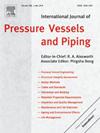Effect of vertical reinforcement on the buckling behavior of thin-walled cylinders subjected to axial load
IF 3
2区 工程技术
Q2 ENGINEERING, MECHANICAL
International Journal of Pressure Vessels and Piping
Pub Date : 2025-02-15
DOI:10.1016/j.ijpvp.2025.105465
引用次数: 0
Abstract
A series of 3D nonlinear finite element models were developed to evaluate the buckling behavior of a thin-walled cylinder with vertical reinforcing ribs evenly distributed around its perimeter. Reinforcement locations in the lower-upper zones, central section, and the entire mantle were analyzed, subjecting the cylinder to an axial compression load at the upper edge of the mantle. First, the 3D finite element models were validated by comparison with experimental results previously reported in the literature. Four reinforcement configurations were then applied to the initial geometry to assess the behavior of the cylinder with and without the proposed reinforcements. Buckling failure and load capacity of the thin-walled cylinders were analyzed. Nonlinearities due to material properties, second-order effects, and initial geometric imperfections were considered. The results show that full-height reinforcement in the compression zone of the mantle increases buckling resistance by 40 % for thin-walled cylinders subjected to axial load. Therefore, this type of reinforcement can be a good alternative to enhance buckling resistance in cylindrical metallic structures, including tanks and silos, subjected to similar loading conditions.
纵向加筋对受轴向载荷薄壁圆柱体屈曲行为的影响
建立了一系列的三维非线性有限元模型,以评估沿其周长均匀分布的垂直加筋薄壁圆柱体的屈曲行为。分析了下上部区域、中部区域和整个地幔的加固位置,使圆柱体在地幔上边缘承受轴向压缩载荷。首先,将三维有限元模型与文献报道的实验结果进行对比验证。然后将四种加固配置应用于初始几何形状,以评估有和没有建议的加固的圆柱体的行为。对薄壁圆筒的屈曲破坏和承载能力进行了分析。考虑了材料特性、二阶效应和初始几何缺陷引起的非线性。结果表明,在地幔压缩区进行全高度加固,可使薄壁圆柱体在轴向载荷作用下的抗屈曲能力提高40%。因此,这种类型的加固可以很好地替代圆柱形金属结构,包括储罐和筒仓,在类似的载荷条件下增强抗屈曲能力。
本文章由计算机程序翻译,如有差异,请以英文原文为准。
求助全文
约1分钟内获得全文
求助全文
来源期刊
CiteScore
5.30
自引率
13.30%
发文量
208
审稿时长
17 months
期刊介绍:
Pressure vessel engineering technology is of importance in many branches of industry. This journal publishes the latest research results and related information on all its associated aspects, with particular emphasis on the structural integrity assessment, maintenance and life extension of pressurised process engineering plants.
The anticipated coverage of the International Journal of Pressure Vessels and Piping ranges from simple mass-produced pressure vessels to large custom-built vessels and tanks. Pressure vessels technology is a developing field, and contributions on the following topics will therefore be welcome:
• Pressure vessel engineering
• Structural integrity assessment
• Design methods
• Codes and standards
• Fabrication and welding
• Materials properties requirements
• Inspection and quality management
• Maintenance and life extension
• Ageing and environmental effects
• Life management
Of particular importance are papers covering aspects of significant practical application which could lead to major improvements in economy, reliability and useful life. While most accepted papers represent the results of original applied research, critical reviews of topical interest by world-leading experts will also appear from time to time.
International Journal of Pressure Vessels and Piping is indispensable reading for engineering professionals involved in the energy, petrochemicals, process plant, transport, aerospace and related industries; for manufacturers of pressure vessels and ancillary equipment; and for academics pursuing research in these areas.

 求助内容:
求助内容: 应助结果提醒方式:
应助结果提醒方式:


